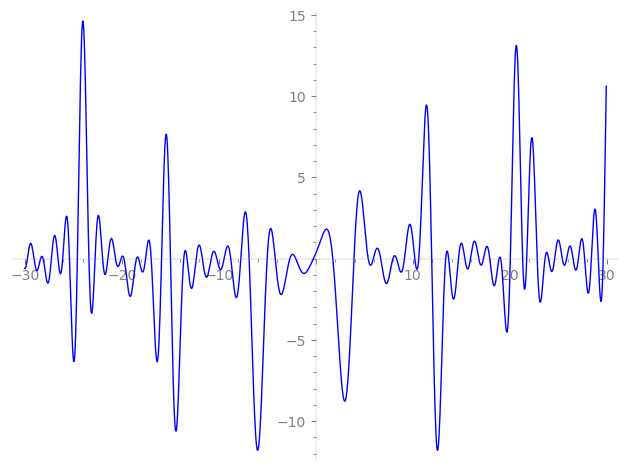| L(s) = 1 | + (−1.31 − 2.28i)2-s + (−2.46 + 4.27i)4-s + 0.846·5-s + (0.241 − 0.417i)7-s + 7.73·8-s + (−1.11 − 1.92i)10-s + (−2.25 + 3.90i)11-s + (−0.355 − 0.615i)13-s − 1.26·14-s + (−5.24 − 9.08i)16-s + (−3.30 − 5.72i)17-s + (−2.96 − 5.12i)19-s + (−2.08 + 3.61i)20-s + 11.8·22-s + (−2.61 − 4.53i)23-s + ⋯ |
| L(s) = 1 | + (−0.931 − 1.61i)2-s + (−1.23 + 2.13i)4-s + 0.378·5-s + (0.0911 − 0.157i)7-s + 2.73·8-s + (−0.352 − 0.610i)10-s + (−0.680 + 1.17i)11-s + (−0.0984 − 0.170i)13-s − 0.339·14-s + (−1.31 − 2.27i)16-s + (−0.802 − 1.38i)17-s + (−0.679 − 1.17i)19-s + (−0.466 + 0.808i)20-s + 2.53·22-s + (−0.545 − 0.944i)23-s + ⋯ |
\[\begin{aligned}\Lambda(s)=\mathstrut & 603 ^{s/2} \, \Gamma_{\C}(s) \, L(s)\cr =\mathstrut & (-0.641 - 0.767i)\, \overline{\Lambda}(2-s) \end{aligned}\]
\[\begin{aligned}\Lambda(s)=\mathstrut & 603 ^{s/2} \, \Gamma_{\C}(s+1/2) \, L(s)\cr =\mathstrut & (-0.641 - 0.767i)\, \overline{\Lambda}(1-s) \end{aligned}\]
Particular Values
| \(L(1)\) |
\(\approx\) |
\(0.136989 + 0.293033i\) |
| \(L(\frac12)\) |
\(\approx\) |
\(0.136989 + 0.293033i\) |
| \(L(\frac{3}{2})\) |
|
not available |
| \(L(1)\) |
|
not available |
\(L(s) = \displaystyle \prod_{p} F_p(p^{-s})^{-1} \)
| $p$ | $F_p(T)$ |
|---|
| bad | 3 | \( 1 \) |
| 67 | \( 1 + (0.565 + 8.16i)T \) |
| good | 2 | \( 1 + (1.31 + 2.28i)T + (-1 + 1.73i)T^{2} \) |
| 5 | \( 1 - 0.846T + 5T^{2} \) |
| 7 | \( 1 + (-0.241 + 0.417i)T + (-3.5 - 6.06i)T^{2} \) |
| 11 | \( 1 + (2.25 - 3.90i)T + (-5.5 - 9.52i)T^{2} \) |
| 13 | \( 1 + (0.355 + 0.615i)T + (-6.5 + 11.2i)T^{2} \) |
| 17 | \( 1 + (3.30 + 5.72i)T + (-8.5 + 14.7i)T^{2} \) |
| 19 | \( 1 + (2.96 + 5.12i)T + (-9.5 + 16.4i)T^{2} \) |
| 23 | \( 1 + (2.61 + 4.53i)T + (-11.5 + 19.9i)T^{2} \) |
| 29 | \( 1 + (1.47 - 2.56i)T + (-14.5 - 25.1i)T^{2} \) |
| 31 | \( 1 + (-1.64 + 2.85i)T + (-15.5 - 26.8i)T^{2} \) |
| 37 | \( 1 + (3.31 + 5.73i)T + (-18.5 + 32.0i)T^{2} \) |
| 41 | \( 1 + (3.93 - 6.80i)T + (-20.5 - 35.5i)T^{2} \) |
| 43 | \( 1 + 7.36T + 43T^{2} \) |
| 47 | \( 1 + (-4.62 + 8.01i)T + (-23.5 - 40.7i)T^{2} \) |
| 53 | \( 1 - 11.0T + 53T^{2} \) |
| 59 | \( 1 + 7.46T + 59T^{2} \) |
| 61 | \( 1 + (-1.40 - 2.44i)T + (-30.5 + 52.8i)T^{2} \) |
| 71 | \( 1 + (1.71 - 2.96i)T + (-35.5 - 61.4i)T^{2} \) |
| 73 | \( 1 + (-1.75 - 3.03i)T + (-36.5 + 63.2i)T^{2} \) |
| 79 | \( 1 + (-1.09 + 1.89i)T + (-39.5 - 68.4i)T^{2} \) |
| 83 | \( 1 + (0.629 + 1.08i)T + (-41.5 + 71.8i)T^{2} \) |
| 89 | \( 1 - 12.9T + 89T^{2} \) |
| 97 | \( 1 + (1.87 + 3.24i)T + (-48.5 + 84.0i)T^{2} \) |
| show more | |
| show less | |
\(L(s) = \displaystyle\prod_p \ \prod_{j=1}^{2} (1 - \alpha_{j,p}\, p^{-s})^{-1}\)
Imaginary part of the first few zeros on the critical line
−10.19316800689141539620892674200, −9.441853864768354706733826562245, −8.759226256699131691898711609556, −7.72484189783942117905360698495, −6.86777288812072714363248379791, −5.00577369023349208682781802705, −4.17685617921122203737111175497, −2.66457726749731307920275146704, −2.05470390366012449777690083828, −0.23476428128231705788506981243,
1.75991119961390388403687073943, 3.94141600833506152948019720157, 5.40709415127408539822577270713, 5.94018924758607434802013572262, 6.69823625716332548820234786518, 7.957717340212991118763651767255, 8.329286418610274259244436210053, 9.148018811421982582091113942685, 10.21369895947212313352921799064, 10.62063868562327168200823981796

